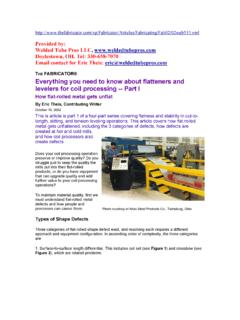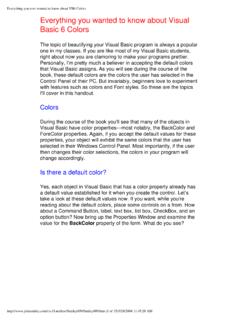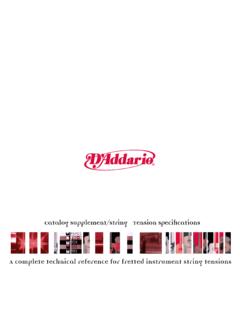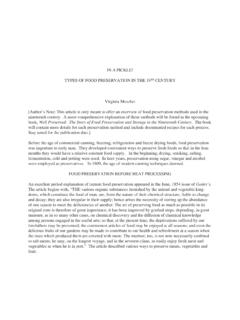Transcription of Everything You Wanted To Know About 4
1 Everything You Wanted To know About Aeration . But Were Afraid To Ask! By Bryan Wood Whether on sports fields, golf courses, or playgrounds, no turf area is immune to the devastating effects of compaction. If you have attended your favorite high school's Friday night football game and looked at the center section of the field, you may see some very sparse turf. Compaction contributes to this obvious high traffic problem and is easy to spot. Other compacted areas can be seen around the goal on a soccer field, the path that always appears between the same two bunkers every time people walk from their cart to the green, or just where people take that proverbial shortcut through the grass to the sidewalk.
2 These are only the visible signs, just the tip of the iceberg , of the compaction problems that are really present in your soil. Now that you know it's there, it must be remedied. The primary means of relieving compaction is through mechanical cultivation, namely aeration. You can choose many methods of aerifying for the differing conditions and situations in a given area, and each will yield differing results. Which method is best: deep or shallow tine, coring or solid tines, oscillating tines, slicing blades, or vertical linear aeration (deep power slicing) ?
3 How to choose what's right for you is the question we want to answer. Having been in the aeration business for over twenty years and having visited thousands of golf courses, athletic complexes, and sports fields in the , Canada, Mexico, and Europe I. have found that the problems are all the same and the options have clear advantages and disadvantages. Everyone wants the perfect playing surface, so let's tackle some frequently pondered decisions. DEEP TINE VS. SHALLOW TINE. Tine pictures from The age-old question is, should I deep tine or shallow tine? Several years ago, Dr.
4 Houston Couch of Virginia Tech spoke on the subject of deep tine aeration and I heard a golf course superintendent ask, My old aerifier went three inches deep and the root system stopped there. My next aerifier went four inches deep and the roots stopped there. Now I started deep tine aerifying and my roots seem to be stopping there. What can I do now? Dr. Couch looked perplexed and humorously responded, And what's the problem with ten inch roots? That little remark encompasses my view in a nutshell. Given the choice, go deep. It's true that the root system usually does stop where the aeration tine stops.
5 But at ten inches deep, the root system will support a healthy stand of turf. I have even seen ten-inch poa annua roots in golf course greens! With a deeper root system from deep tine aerification, irrigation intervals can be lengthened, fertilizer applications last longer, and more oxygen is introduced into the soil. Some other benefits to deep aeration should be mentioned. For example, some golf courses have completely amended the top 12 inches of their greens soil profile through the creation of deep sand tunnels from topdressing after using large tines and up to 1-1/2 tons of sand per thousand square feet!
6 This amounts to virtually rebuilding the green from the inside out without taking it out of play and results in a savings of thousands of dollars. The old rolling type shallow aerifier is still cheap and fast, but there is minimal compaction relief and generally produces tufting around the holes. Now with the new designs of deep tine heaving machines that are faster than ever before (over two acres/. hour), deep tine aeration is now even a more economically feasible option for multiple athletic complexes or golf course fairways. As a side note, before you start a deep tine aeration program, just make sure the irrigation lines and wires are deeper than then the aerifying depth.
7 I've seen lots of "scenic fountains" pop up unexpectedly during deep aerification. STRAIGHT UP AND DOWN (SUD). VS. John Deere Aercore 2000 (SUD Type) Wiedenmann XF 8 (Heaving Type). HEAVING ACTION. (pictures are for example purposes only). Another question to answer is whether to choose a machine with "straight up-and-down" (SUD) tine action or heaving action. I recommend a heaving action aerifier for most applications. Due to the SUD action of conventional aerifiers, compaction relief between the holes is minimal at best. SUD. aerifiers, although still manufactured, are a bit out of date given the newer technologies available in aerifying.
8 Even the vertical drilling machines produce little to no compaction relief between the holes. I recommend choosing an aerifier with a positive heaving action that breaks up the compacted soil between the holes. This introduces needed oxygen, will increase the total cat ion (kat-i-on) exchange capacity, and can improve drainage both horizontally and vertically throughout the soil profile. Plus, at the bottom of each stroke, the heaving tine is moving horizontally as it is moving vertically, thus having a slicing plus a lifting action to the turf. This type of action minimizes the creation of a hardpan layer caused by the traditional pounding action of the old SUD aerifiers.
9 Rather than compressing the soil and actually adding to the compaction problem, the process of heaving displaces the soil upward, raising the playing surface from not noticeable at all to to of an inch , depending on how the machine is adjusted. Matching the extent of the heave for the given soil conditions can be critical in producing good quality results. For example, after using needle tines, the putting surface should be smooth without using any topdressing and should putt smoothly even after using larger tines and a light topdressing. SOLID TINE VS. CORING TINE.
10 Tine pictures from With turf managers and golf course superintendents aerifying year-round for different specific reasons these days, here is a brainteaser question to answer: Should you use solid or coring tines? The answer depends first on what style aerifier you're using and then the problems being addressed. Some say that solid tines cause compaction, but they don't quite have their facts straight. It's not the solid tine that causes compaction, but the machine it's attached to. Solid tines are available for both straight-up-and-down (SUD) or heave action aerifiers.





